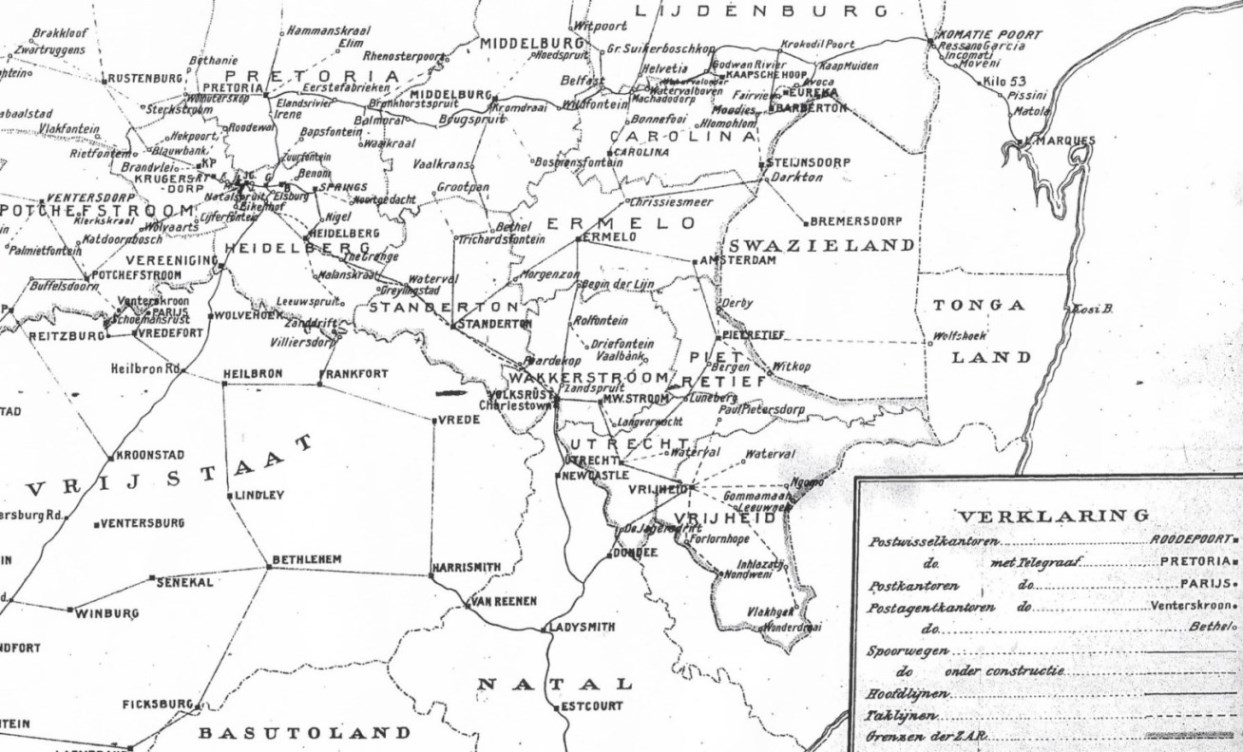This is the first known cover we have seen posted from Swazieland to Mrs. Head. The handwriting can be identified as that of Miss. Clara Harris. There are five half-penny South African Republic postage stamps, which make up the 2½d, ½ oz rate to the British Isles. They are tied by four Darkton squared circle datestamps in black and dated 12th March 1894. On the reverse, three datestamps record Johannesburg for the 15th March, Cape Colony for the 20th March and a Wimbledon single circle arrival datestamp, for the 10th April 1894.
The half-penny stamps were designed by Joseph Vürtheim and printed by Enschedé & Son, Haarlem, Netherlands. These half-penny postage stamps were first issued by the South African Republic on the 30th March 1885.
From 1889 Swazieland was jointly controlled by the South Africa Republic and the British Government. Nevertheless, the South African Republic organised the postal system, using their adhesive postage stamps which were overprinted 'Swazieland'.
The Post Offices or Post Office Agencies were located at Darkton, Bremersdorp the principle town and Head Post Office, and Embekelweni which was located near to the Swazi King’s Kraal. On the 1st September 1895 Embabaan was the fourth Post Office to open.
The overprinted stamps were withdrawn, circa July 1892, and the adhesive un-overprinted stamps were used.
During February 1895, Swazieland became a Protectorate of the South Africa Republic until the end of the South African War. The datestamps at Darkton, i.e. on the cover above, have ‘SWAZIEL’ at the foot. These continued in use for a while until new datestamps were issued with ‘Z.A.R.’ at the foot.

Detail from the South Africa Republic postal route map of 1895, which shows the rough postal routes in the South Africa Republic and Swazieland. The distance between Darkton and Pretoria was over 200 miles. The nearest railway to Darkton was Barberton, which opened in 1896.
Mail from Darkton probably went first by mule postcart or horse-rider to Steynsdorp, in the South Africa Republic, a journey of just four hours. From there, it went to Chrissiemeer or to Barberton, where it travelled to Pretoria or Johannesburg. Once controlled by the post office, the mail started the long journey south, to Cape Town in Cape Colony. Then shipped to a port in southern England, by train to London, delivered to the Wimbledon sorting office and thus via the postman to Mrs. Head in Lingfield Road.
During 1894 the Postal Agency at Darkton handled 23,903 postal items.
These were made up as follows:
Service Letters = 564
Ordinary Mail = 12,154
Newspapers = 10,825
Books = 87
Registered items = 273
References
Higson, Andrew, in Swaziland Philately to 1968, (2013), edited by Peter van der Molen, South Africa, pp.1-14.
Higson, A., (2006), Swaziland 1895-1910, The Transvaal Philatelist, 159/43-56.
Higson, A., (2009), Darkton, 1895, The Transvaal Philatelist, 171/51.
Higson, A., (2009), The "Mrs Head" Correspondence, The Transvaal Philatelist, 172/93.
Høgberg, F., (2011), Some Early Swaziland Covers, The Transvaal Philatelist, 178/34-39.
van der Molen, Peter, (2013), Swaziland philately to 1968, South Africa, p.31.
Postkaart van de Z.A.Republiek uitgegeven door den Postmeester Generaal, Pretoria Januari 1895.
- - PLEASE USE YOUR BROWSER RETURN KEY to return to previous page - -
- - SAGM Cover List - -Copyright © 2021 J. Woolgar and those who own the covers illustrated here